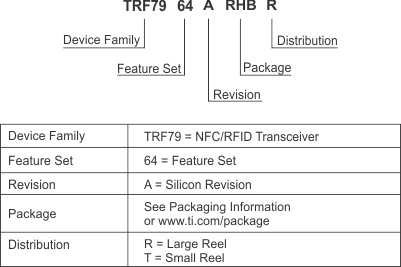SLOS787J May 2012 – March 2020 TRF7964A
PRODUCTION DATA.
- 1Device Overview
- 2Revision History
- 3Device Characteristics
- 4Terminal Configuration and Functions
- 5Specifications
-
6Detailed Description
- 6.1 Overview
- 6.2 System Block Diagram
- 6.3 Power Supplies
- 6.4 Receiver – Analog Section
- 6.5 Receiver – Digital Section
- 6.6 Oscillator Section
- 6.7 Transmitter – Analog Section
- 6.8 Transmitter – Digital Section
- 6.9 Transmitter – External Power Amplifier and Subcarrier Detector
- 6.10 TRF7964A IC Communication Interface
- 6.11 TRF7964A Initialization
- 6.12 Special Direct Mode for Improved MIFARE Compatibility
- 6.13
Direct Commands from MCU to Reader
- 6.13.1
Command Codes
- 6.13.1.1 Idle (0x00)
- 6.13.1.2 Software Initialization (0x03)
- 6.13.1.3 Reset FIFO (0x0F)
- 6.13.1.4 Transmission With CRC (0x11)
- 6.13.1.5 Transmission Without CRC (0x10)
- 6.13.1.6 Delayed Transmission With CRC (0x13)
- 6.13.1.7 Delayed Transmission Without CRC (0x12)
- 6.13.1.8 Transmit Next Time Slot (0x14)
- 6.13.1.9 Block Receiver (0x16)
- 6.13.1.10 Enable Receiver (0x17)
- 6.13.1.11 Test Internal RF (RSSI at RX Input With TX ON) (0x18)
- 6.13.1.12 Test External RF (RSSI at RX Input with TX OFF) (0x19)
- 6.13.1
Command Codes
- 6.14
Register Description
- 6.14.1 Register Preset
- 6.14.2 Register Overview
- 6.14.3
Detailed Register Description
- 6.14.3.1 Main Configuration Registers
- 6.14.3.2
Control Registers – Sublevel Configuration Registers
- 6.14.3.2.1 ISO/IEC 14443 TX Options Register (0x02)
- 6.14.3.2.2 ISO/IEC 14443 High-Bit-Rate and Parity Options Register (0x03)
- 6.14.3.2.3 TX Timer High Byte Control Register (0x04)
- 6.14.3.2.4 TX Timer Low Byte Control Register (0x05)
- 6.14.3.2.5 TX Pulse Length Control Register (0x06)
- 6.14.3.2.6 RX No Response Wait Time Register (0x07)
- 6.14.3.2.7 RX Wait Time Register (0x08)
- 6.14.3.2.8 Modulator and SYS_CLK Control Register (0x09)
- 6.14.3.2.9 RX Special Setting Register (0x0A)
- 6.14.3.2.10 Regulator and I/O Control Register (0x0B)
- 6.14.3.3
Status Registers
- 6.14.3.3.1 IRQ Status Register (0x0C)
- 6.14.3.3.2 Interrupt Mask Register (0x0D) and Collision Position Register (0x0E)
- 6.14.3.3.3 RSSI Levels and Oscillator Status Register (0x0F)
- 6.14.3.3.4 Special Functions Register (0x10)
- 6.14.3.3.5 Special Functions Register (0x11)
- 6.14.3.3.6 Adjustable FIFO IRQ Levels Register (0x14)
- 6.14.3.4 Test Registers
- 6.14.3.5 FIFO Control Registers
- 7Applications, Implementation, and Layout
- 8Device and Documentation Support
- 9Mechanical, Packaging, and Orderable Information
Package Options
Mechanical Data (Package|Pins)
- RHB|32
Thermal pad, mechanical data (Package|Pins)
- RHB|32
Orderable Information
8.2 Device Nomenclature
To designate the stages in the product development cycle, TI assigns prefixes to the part numbers of devices. Each commercial family member has one of three prefixes: x, p, or no prefix. These prefixes represent evolutionary stages of product development from engineering prototypes (with prefix x) through fully qualified production devices (with no prefix).
Device development evolutionary flow:
xTRF... – Experimental device that is not necessarily representative of the electrical specifications of the final device
pTRF... – Final device that conforms to the electrical specifications of the final product but has not completed quality and reliability verification
TRF... – Fully qualified production device
Devices with a prefix of x or p are shipped against the following disclaimer:
"Developmental product is intended for internal evaluation purposes."
Production devices have been characterized fully, and the quality and reliability of the device have been demonstrated fully. TI's standard warranty applies.
Predictions show that prototype devices have a greater failure rate than the standard production devices. TI recommends that these devices not be used in any production system because their expected end-use failure rate still is undefined. Only qualified production devices are to be used.
TI device nomenclature also includes a suffix with the device family name. This suffix indicates the package type and, optionally, the temperature range. Figure 8-1 provides a legend for reading the complete device name.
 Figure 8-1 Device Nomenclature
Figure 8-1 Device Nomenclature